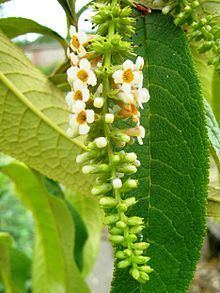Rank Species | ||
 | ||
Similar Buddleja macrostachya, Buddleja nivea, Buddleja myriantha, Buddleja delavayi, Buddleja albiflora | ||
Buddleja forrestii is a deciduous shrub or small tree widely distributed from India to western China. First described by Diels in 1912, he named the species for plant hunter George Forrest, who discovered the plant in Yunnan in 1904 and introduced it to Western cultivation.
Contents
Description
B. forrestii grows to < 6 m in height in the wild. The branches are tetragonous, and bear lanceolate leaves, which are opposite, < 25 cm long; the undersides covered with reddish-brown hairs. The species is chiefly distinguished by its inflorescences, pendulous terminal panicles < 25 cm long comprising virtually scentless flowers which appear in late summer; their colour varies considerably, ranging from pale maroon, through mauve, and blue, to almost white. Ploidy 2n = 114 (hexaploid).
Cultivation
B. forrestii is not fully hardy in the UK, and best grown against a south-facing wall, or in pots which can be removed to the greenhouse or conservatory in winter. A specimen is grown as part of the NCCPG national collection at Longstock Park Nursery, near Stockbridge, Hampshire. Hardiness: USDA zones 8–9.
